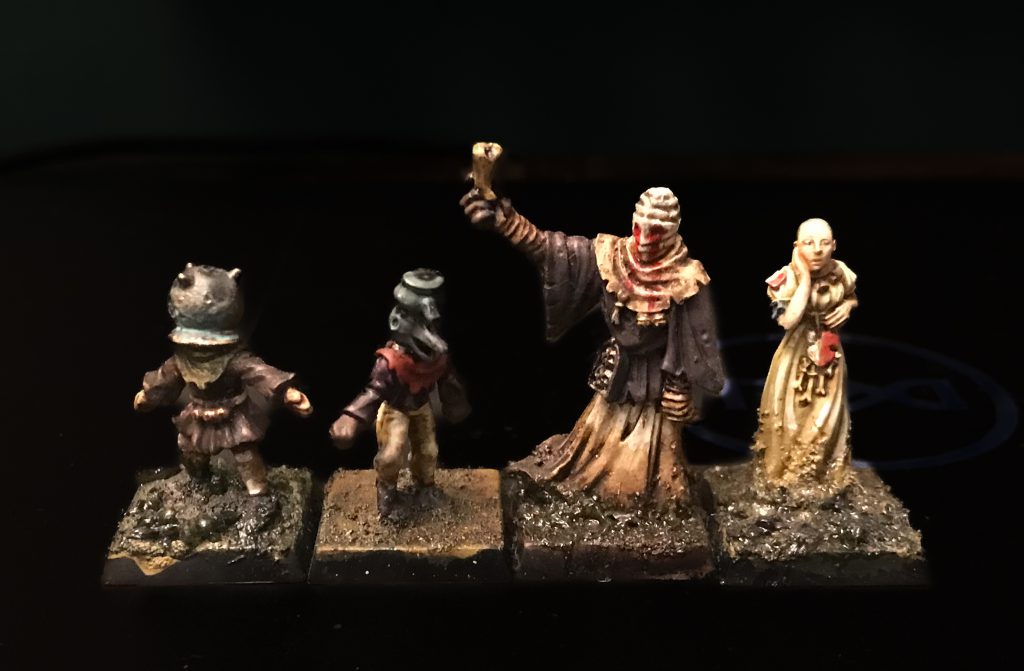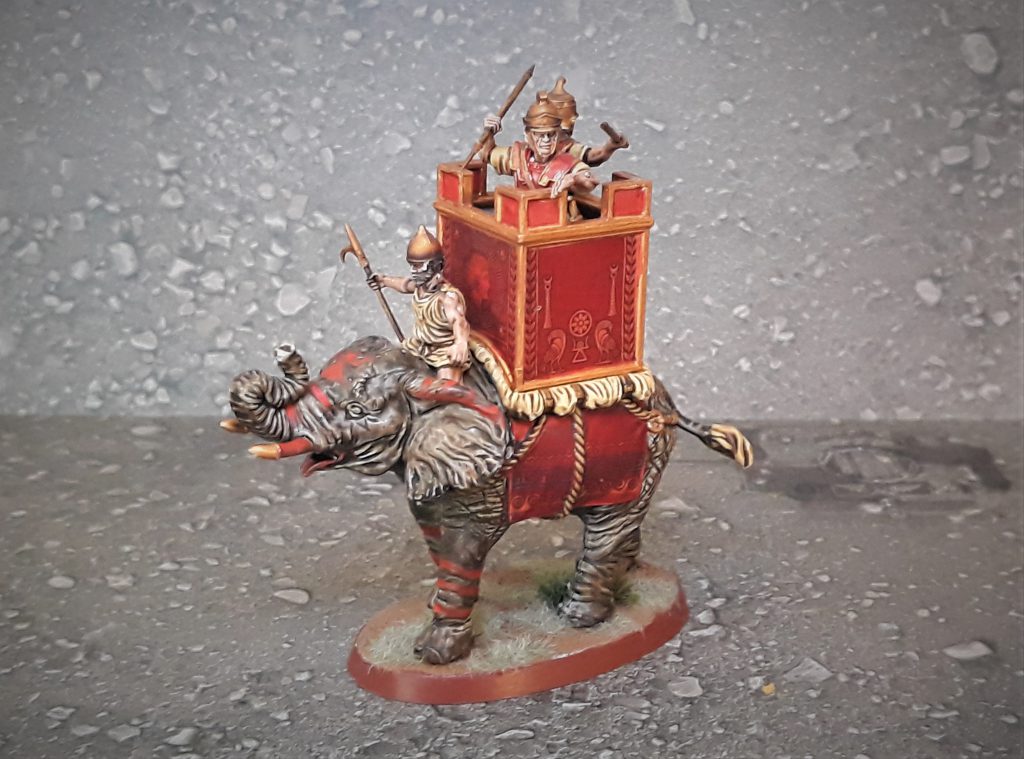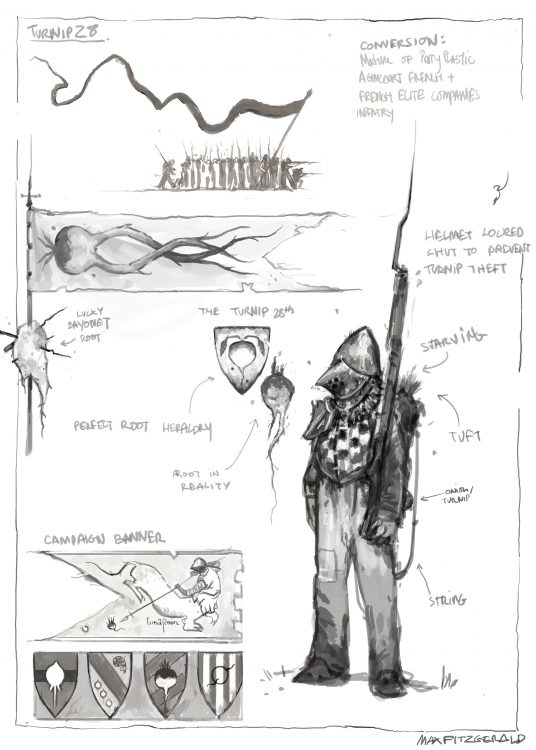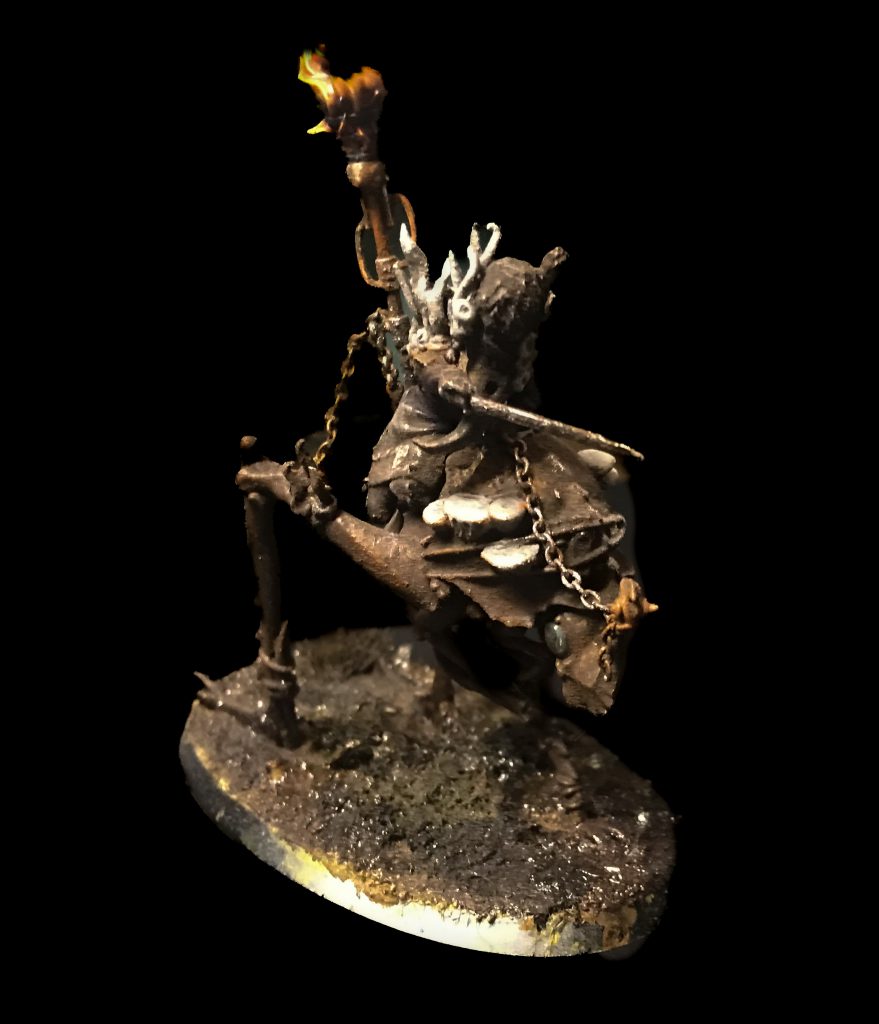Howdy and welcome to a (later than expected) follow up article on Turnip 28! A while ago we talked about the reasons you should be playing this mad game. An important aspect of the game that was touched on in that article were the Cults.
Cults act as your factions in Turnip 28, and add a lot to the game. Some Cults add new units you can take, and some of those are built almost entirely around their unique unit, but others are more focused on the strange gameplay twists and minigames that they add on top of your generic units.
One thing that Turnip does that I really appreciate is that it organizes it’s factions by complexity. It has a system (themed around the life cycle of a toad, which is appropriate) that sorts factions into beginner, intermediate, and expert. This is honestly kind of genius and I wish more games had it.

There is nothing like latching on to a faction in a game, spending a lot of time building and painting them, only to discover that they are difficult to play. It sucks and I am glad that that information is up front. Another fun bit is that there is a page of FAQs and strategies/tactics for playing each Cult, immediately after their rules page. This helps you get a grip on some of the more difficult to grasp factions, and is much appreciated considering how strange some of these get.
In no particular order, but divided by difficulty level, I am going to go over the cults and give a short description of how they work. I will only be going over the Tadpole and Toadlet difficulty cults today, as the Toad Cults, or expert level Cults, tend to be very strange, very finnicky, and kind of hard to explain. Rating relative power levels is something that I haven’t played enough games to do yet, and some Cults I bluntly do not know how to evaluate.
Tadpoles
Tadpoles are the easiest difficulty level, and tend to be simple to play, with straightforward mechanics and gimmicks that don’t take too long to explain.
Stranglin’ Harry’s Wretched Recruits

Stranglin’ Harry’s is the first cult in the book and is explicitly designed as a beginner cult. It provides an extra wound on your officers and helps you clear panic off of your troops if you perform certain actions that you really should be doing anyway. Explicitly rewarding good play is a good idea for a beginner faction. It also lets you take a unit of rootlings, which are horrid little goblins that are described as having been spawned from a horrible bucket of slime. They are interesting and can be placed back on the table after being killed, which makes them forgiving for new players, which is appropriate.
All in all this is a great beginner faction, and it sets a good tone for the rest of them.
The Slug’s Lament
The Slug’s Lament rocks. It’s key feature is that it lets you take this game’s version of Chaos Warriors, Grogs, highly elite troops that are braver, tougher, and shoot much better than any other troop in the game. It’s second feature is that your Toff and one free unit of Grogs arrive several turns into the game as an outflank, showing up on a board edge to reinforce. This means that several of your units are going to be without command or orders, so those better stats are less overpowering than you would think.
I really like the Slug’s Lament, they are an elite army that, rather than just being outnumbered, will frequently be out commanded. They require more finesse than Stranglin’ Harry’s, but are still easy enough to understand to be a good one for newer players.

Tod’s Folly
So when I said I really didn’t know how to evaluate how good or bad some Cults were competitively, Tod’s Folly is the one that immediately sprang to mind. Tod’s Folly is weird.
For one, your Toff is replaced with a horrid little toad man named Tod, who has remarkably bad stats but a lot of wounds. This is already a fun modelling opportunity, but where the Cult goes nuts is it’s special rule. They lose any combat they would win, and win any combat they would lose. So if you have a unit of Fodder with swords out in the open and they get shot to pieces, losing 4 guys, you actually win that combat and the enemy is forced to retreat.
This is very, very confusing, and completely fucks with the math of the game in a very strange way, because you are now trying to take the worst fights you can without losing the entire unit, as this rule doesn’t work if the whole unit dies.
I have no way of knowing how good or bad this is without playing a ton of games both as and against Tod. I know that it seems completely agonizing to play against, but it is also probably the most Turnip-y out of all of the Cults. Take bad fights, do idiotic charges, and win anyway because you are a really confident horrid little toad man. I love it.
The Fungivorous Herd
The Herd (I am not typing that first word again) is another really fun cult. It lets you take a herd of ambiguously domesticated animals as a troop, and every time you move them through dangerous terrain, they can gain more animals, presumably that crawl out of the swamp to join them.
The idea of an ever-growing horde of animals rampaging around the table is very, very fun. They do cap at 12 models in the herd, but that just means you need to be throwing them into combat constantly, and then pulling them back into the swamps to grow the herd. The rest of your list takes less penalties from Dangerous Terrain, so you are generally encouraged to jump out of the swamps and into people, which is appropriate to the flavor of the Cult.
I really like this one, and the only reason I haven’t played it is a shortage of good farm animal models to convert in my local area.
The Grand Bombard
Ok this one rules. The Grand Bombard is an entire list built around one unreasonably massive fuckoff cannon. Each objective you take acts as a spotter for the gun, making it more accurate, and in a pinch you can rise up and throw off the shackles of oppression by making use of the “Aristocratic Ammunition” rule, where you sacrifice one of your officers to get an extra round of shooting with the cannon, as your men grab him and jam him into the gun as an improvised cannonball.
This is the first of what I would like to call “Minigame Cults”, which are Cults where you play some sort of mini/sub game to effect the main game layer. This Cult’s minigame is simple, just spotting the guns with more and more board control, but these get pretty wacky and pretty fun.
Overall I have played this cult a few times now and really enjoy it. The Grand Bombard itself has some heinous damage output, capable of wiping whole units in a single shot, but is very, very inconsistent until it is sighted in.
Band of the Wurm

The Band of the Wurm are the first of the Mercenary Cults, which are in a separate PDF from the main rulebook. The Band of the Wurm’s gimmick is numbers. They can take pike blocks of 16 models, significantly more than the 12 you get in a unit of Fodder, but you are not allowed to take Fodder and are very much encouraged towards huge infantry swarms by all of the mechanics the faction has.
Their Toff also has a mechanic where he can distribute a buff after he dies, basically trading his ability to command his men for an incredibly large offensive buff, tripling the attacks of a unit of pikemen and increasing their movement speed to help them get into close combat. Band of the Wurm armies want to leverage their pikemen as much as they can, which will lead to them being short on ranged damage and other troop types.
This isn’t really my speed in terms of this game, as I am a massive fan of guns, but it seems both pretty powerful and a lot of fun if you like running infantry swarms or just really like the look of a good pike block. Getting your own leader killed at a critical moment seems like a big part of playing this Cult, as the offensive buff he can give on death is completely insane if used in the perfect situation.
March of the Proboscis
This Cult gives you a single Battle Elephant. The Elephant, otherwise know as the Great Proboscis, is a huge, difficult to kill monster that can do a pretty great amount of damage in the right situation and can very heavily panic your enemies forces, which seems appropriate.
In addition, your units find it easier to charge enemy units that are panicked to some degree, so the Great Proboscis’s ability to spread panic tokens around will really help the rest of your army get into melee. The special ability your Toff gets, which lets them grant one unit Bowel Loosening Charge once per game, just adds even more panic for your enemy.

Overall this Cult seems fun, messing with panic is a powerful and somewhat rare effect in this game and there is nearly no way to remove it. There are a couple of Cults that really don’t mind being panicked as much as others, and the Proboscis will probably do much less well against them.
Toadlets
Toadlets are the next tier up in difficulty, either encouraging weird patterns of play, having strange minigames you have to play, or being much more unforgiving than the tadpole cults, possibly all three at once.
The Brotherhood of Greed
The Brotherhood of Greed are a cannibalistic horde led by several heavily mutated (and, we are told, completely delicious) aristocrats. The Aristocrats each have a mutation you choose for them at the beginning of the game, and can roll a die and risk death to cut off part of their body, feed it to one of your units, and grant that mutation to that unit for a turn.
This is gruesome, but the special rule is named “An Occasional Treat”, which is a great example of the game using fun wording to make the horrible, horrible nature of this world into great black comedy. You also can have your units eat one member of the unit to add 4 extra shooting attacks any time they shoot, which can be a pretty potent damage buff in the right situation.

The various mutations allow you to tailor the force pretty heavily, though they do seem to want pretty big infantry blocks with ranged weapons to make the best use of their traits.
I love the Brotherhood of Greed, and they are probably the easiest of the Toadlet cults to play. They are mostly in this tier because remembering all of the mutations that you chose, and which Snob has each one, can be somewhat annoying, and there will be games where you picked the wrong ones and end up struggling when you could have easily won by taking a different mutation.
The Procession of Woe
The Procession of Woe is a pretty convoluted and VERY melee focused cult. They have a big shrine instead of a Toff, and can use it to move panic tokens around their force from one unit to another. They can also take panic tokens and move them from one of your units to one of your opponent’s units.
Their officers can grant the Fearless rule to a unit they order at the cost of giving it a panic token. However, each unit they have that has 2 or more panic tokens gains an extra melee attack, which is a pretty strong buff. Also, by virtue of being a massive shrine with a lot of wounds, your leader will basically always win duels with the enemy’s leader.
The Procession of Woe is a bit convoluted and really leans in to this game’s morale mechanics, and as a melee-heavy cult without any new unit types you will probably lack shooting, because your buffs do nothing for shooting units, leaving them completely generic. Probably still good, but risky.
The Red Ribbon Society
Oh god so remember how I mentioned “Minigame Cults” earlier? This is the minigamiest of them all. So, you are fighting a battle with your opponents, but at the same time you are controlling up to 6 gardeners who go into the various terrain pieces around the board, once per turn.
These gardeners are trying to grow the best prize vegetables for the next village fete, and the amount of vegetables in a terrain piece will double each turn. If the enemy moves a unit into the terrain piece, they will smash all of your vegetables and murder that gardener, so you are trying to keep them safe.
You can spend the vegetables that your gardeners grow on a variety of buffs for your units. This is, in fact, completely mad and one of the weirdest factions I have seen in a tabletop wargame, essentially giving you worker units and resource collection mechanics like an RTS. You need to keep your Age of Empires villagers safe so they can grow vegetables to make your army big and strong and it is bizarre.
I have no idea how to evaluate the quality of this cult, as it will be very dependent on terrain, table layout, and game length. I am glad it exists because it is completely nuts to be able to say that this wargame has a vegetable growing minigame, and I really need to model up some root vegetables and get farming sometime soon.
The Feast of Charybdis
The Feast is another “Big Monster” cult, like the March of the Proboscis. It gives you up to two giant crabs, and lets you burrow them (and one other unit) underground, and you can have them burst out of a terrain piece later in the game.
The Big Crab has a rule where it can never be declared the winner of a combat, if they win a combat then they have to fight again with the enemy unit. This means that once they get in combat, they will fight until either they die, they run, or the entire enemy unit is dead. This is a twist that a lot of units are not ready for, and it means that there will be more total squad wipes than usual when using Big Crab.
This is deceptively powerful, because units run away a lot in Turnip 28, and the Big Crab takes away your opponent’s ability to run away from a combat they are losing, which is brutal.
This is a fun cult and a fun opportunity to convert Big Crab. All hail Big Crab.
Knights of Shellwood

The Knights are a bunch of noble, Brettonian style knights, riding snails. You can take 2 of them, and they are nearly indestructible by this game’s standards with a 3+ save. If they haven’t moved this turn they get a 2+ save, which is a lot of durability.
They also force the enemy to increase their inaccuracy by 1 while shooting at them, making them incredibly annoying to kill. The problem though is that they move 0 inches. And it isn’t just the knights, every unit in your army moves 0 inches.
This seems like a complete gag, but in Turnip 28 you always get a D6 or two of extra movement every time you take a move order, so they can still move, just agonizingly slowly. Another fun thing about their slow nature is that they force the game to go on for one more turn than it normally would. So if the scenario says 4 turns, you have to play 5. Once per game though, all of your cavalry, the snail knights included, can move 18 inches in a huge burst to get into close combat.
This is an odd Cult that I am unsure how to evaluate. For most of the game you will be slow rolling around the battlefield, until you burst forwards and slam into the enemy, being a massive fucking problem for them for the rest of the game as the enemy has to figure out how to kill multiple 4 wound models with at worse a 3+ save and at best a 2+.
They feel a lot like Warhammer Fantasy Ogre Kingdoms, being a bowling ball you toss in your opponent’s direction and figuring out how to stop it is their responsibility. They are just a very, very slow bowling ball.
Lopers of the Maudlin Marsh
The Lopers can take 2 units of Lopers, which are boys on stilts, and can buff their units by taking a boy on a stilt to spot for their ranged weapons. Stilt Boys can be shot from any distance, rather than your opponent being forced to shoot the closest unit like normal.
This Cult has actually changed since the last time I read this, they used to have a rule where they were forced to move exactly 12 inches, which made them very difficult to control and somewhat unfun. Now they can move over both friendly and enemy units, and are forced to retreat directly towards the enemy after losing combat, rather than retreating directly away. This is weird but seems mitigatable for most forces, and might even be a good thing considering that Lopers are melee units, as it will help them get closer after getting shot.
The Lopers are a good example of the evolving nature of the game, having changed pretty significantly since the last time I looked and having gotten significantly better and easier to use. I would never have played the older version, but this new one seems cool, with a bunch of fast, tottering weirdos on stilts that are coming to step on everyone.
The Wigmaker’s Legacy
This cult is batshit insane, and comes from the Mercenary Cults PDF. So, you start out with a Toff/Commander named Syphillus the Magnificent, who is a horrible little Rootling goblin creature. He can, at the beginning of his activation, force every unit with a Powder Smoke token to take a dangerous terrain test.
He also sucks shit stat wise and will die constantly, which is ok because he can respawn at the beginning of every turn in any piece of dangerous terrain on the board. He also gets exactly 2, no more and no less, units of Rootlings with guns, and up to one cannon. All of these units can also respawn when destroyed in the same manner as Syphillus the Magnificent.
The Rootlings and Syphillus also auto-pass all Dangerous Terrain checks, letting them move through whatever they feel like without worrying about it, and making them immune to Syphillus’s special ability. In addition, any time one of your units generates a powder smoke token, they also give one to the opponent’s unit. This is a massive grab bag of traits that leads to a gameplay loop of shooting, putting smoke everywhere, making everyone on the table take a dangerous terrain check, and then all dying and wandering out of a swamp to do it again.
I love this cult, it feels a lot like Tod’s Folly where you are heavily encouraged to take somewhat bad fights, because you can just get back up and keep going. It seems like it would potentially be cheesy, but as only your main officer can respawn, if you are too reckless you will run out of ability to command your dudes pretty quick and get out activated.
Lady Illiana’s Guttersnipes

This cult lets you play as a whole mob of snipers. Your leader gets a huge sniper rifle that they are allowed to shoot before the game even starts after all units have been deployed. Both her and your 3 allowed units of Guttersnipes can make a pre-game move, which helps them get into good positions, and the Guttersnipes are allowed to shoot any unit, not just the closest unit.
You are forbidden from winning the game by killing all of the enemies officers, as you will have a much easier time of it than most of the other cults in the game due to the sheer amount of snipers on your end of the table. You also can place little tokens on the board, and either teleport your snipers to them, or use them to provide an accuracy bonus to a unit. Guttersnipes shoot first in ranged combat, which lets them lower the amount of fire coming their way and makes them more durable than you would think in practice.
This is a cult that is pretty defined by its unique unit, and is slippery and annoying, which is perfect from a force of snipers. No further comments, its good.
Conclusion
God the Cults are good. Not all of them are even in power, not even close, but all of them in some way mess with the core mechanics and flow of the game in a way I really enjoy.
My personal favorites out of the ones we have looked at so fare are the Slug’s Lament and The Wigmaker’s Legacy, but any one of these could be someone’s favorite and I wouldn’t really be able to contest that. We will be covering the more advanced, Toad level cults next time, as this article is already massively over-length. Hope y’all have a good day, and put some horrible little mud men on the table to strangle each other.
Questions, comments, suggestions, bizarre and horrifying turnip conversions to share with us? contact@goonhammer.com
![IMG_0180[1]](https://d1w82usnq70pt2.cloudfront.net/wp-content/uploads/2023/04/IMG_01801-696x473.jpg)


You must be logged in to post a comment.